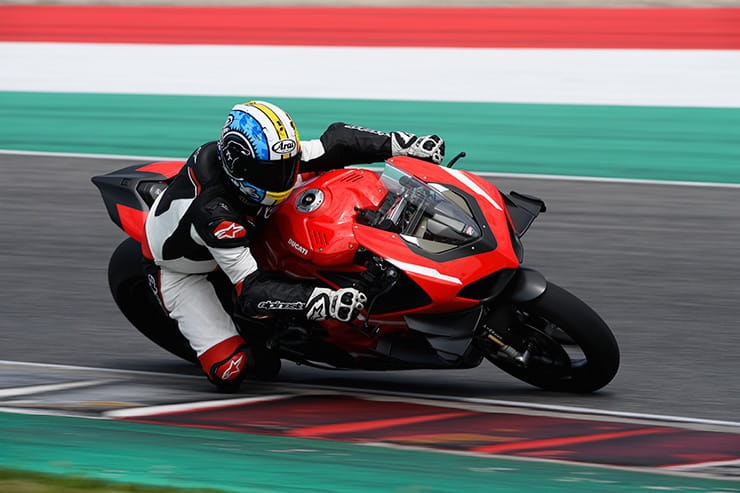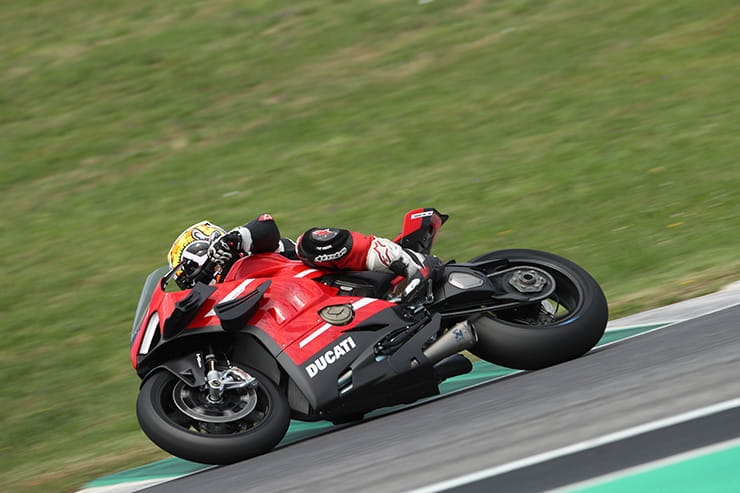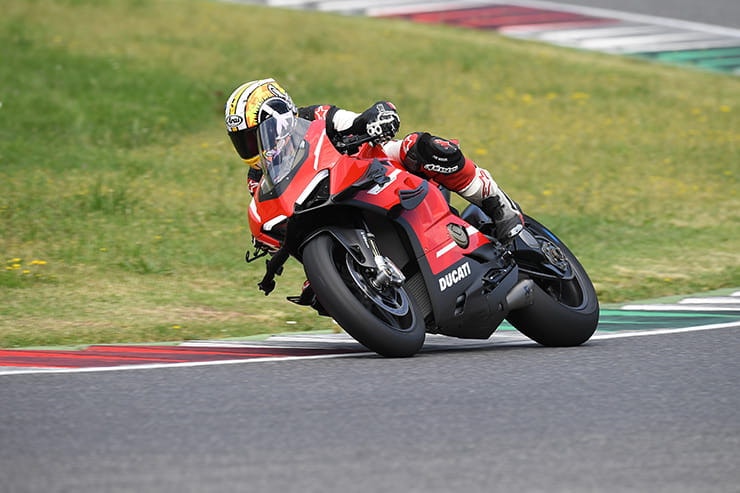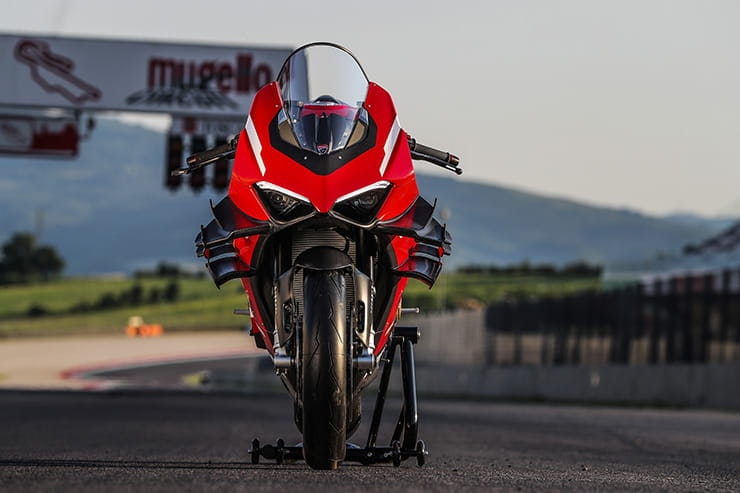Ducati Superleggera V4 (2020) - Review
BikeSocial Road Tester
02.07.2020
Just arriving at Mugello, one of the grandest tracks in the world, sends shivers down your spine. To also have the privilege of becoming the first Brit to ride Ducati’s V4 Superleggera (and only the second person outside Ducati to sample one too), means the pressure is on. Claudio Domenicali, the CEO of Ducati, is next in line after me.
Awaiting in a scorching Mugello garage is my Superleggera, lovingly prepared of course - Pirelli slicks wrapped in tyre warmers. I pre-select my rider mode ‘Race B’, which reduces the torque in first and second gear – though I have the option to flick into the full power A mode whilst riding.
I’m given the nod to prepare. The engine fires up with a press of the starter button. Ducati has fitted the race exhaust, which gives the full 234hp and an intoxicating exhaust note. A few blips of the throttle send a spine-tingling welcome around the amphitheatre of Mugello. I let the revs drop, soak in the dry clutch rattle and give the brake lever span adjuster (on the left) a quick turn. It’s a conventional down-change into first gear, then clutch out and we’re down pit-lane to join an empty track. Does it get any better than this?
WSBK levels of usable power
Amazing handling and brakes
Stunning looks and exclusivity
Price
Friends now hate me
I’ll probably never get to ride one again
2020 Ducati Superleggera V4 price
£90,000. Even if you say it fast, it’s a huge amount of money, and with only 500 units available worldwide, most will go into collections. The justification is that you’re buying an investment. Older Superleggeras are holding their value or increasing. In a few years you’ll make a return on your investment – that’s what I’m telling my wife, but she is having none of it.
We ride Ducatis £90,000 Superleggera V4
Ducati’s 234hp (race kit) Superleggera, their fastest most powerful and advanced production bike ever!
Power and torque
In road trim it makes 224bhp, which is only 3bhp more than the V4-R it is based on. But that number is only the half the story because it’s how the power is delivered that matters. In track trim this Ducati might have the power of the factory’s WSBK contender, or near as damn it, but it’s usable and smooth. This is evident on the first lap whilst getting accustomed to my surroundings, as I short-shift easily through the ratios without troubling the shift lights. Peak power is at 15,250rpm and peak torque at 11,750rpm but the frictionless V4 will rev even higher, to 16,000rpm, while the rev limiter in sixth gear is at a giddy 16,500rpm.
I start to gel with bike and circuit but despite getting into the flow and really starting to make the engine scream, the front end remains planted. In my chosen riding mode (Race B) there’s no hint of a wheelie or instability and it feels like playing an Xbox game, in which I can ride with impunity – just dial in a fistful of power and drive forward with eye-popping acceleration.
Mugello is wide and open but still the Superleggera shrinks it to the size of Mallory Park. Now I’m only changing gear when the shift lights illuminate, and in no time at all I’m in fifth gear and tap into top before that notorious blind rise down the long straight at Mugello. This. Is. Fast.
I’ve ridden monstrously powerful WSBK Ducatis before, but this Superleggera is incredibly forgiving and easy considering its jaw-dropping power. As my bravery and confidence improve I flick to A mode, which delivers full power and torque in the lower gears. To be fair, Mugello isn’t a wheelie-happy track (I only used first gear to leave pit-lane) but in this sharper mode there’s certainly more kick lower down. Again, the front is unflustered, only lifting slightly on the first application of throttle when the wings aren’t really working at low speeds.
Engine, gearbox and exhaust
The 998cc Stradale V4 is taken from Ducati’s ‘top-spec’ V4-R Panigale, itself an extraordinarily compact and lightweight engine. Each engine is hand-built, the Desmo valve timing (no springs) are set up at the factory by a specific engineer who signs off each bike once he’s happy and everything is set perfectly. Even though the engine is producing an eye-watering 234hp, service intervals remain the same as the standard V4 at 7500miles.
Ducati engineers managed to shave 2.8kg from the engine, while the road-legal Akrapovic exhaust is 2.5kg lighter than the standard V4 item, and the full race system, which takes power to 234hp, saves a whopping 6kg from standard. Peak power is 224bhp in standard road trim, or 234hp with the supplied race exhaust, which is only around 10bhp short of the factory’s World Superbike V4-R. Even with its homologated power output of 224bhp, that’s enough to give the it record-breaking power to weight ratio of 1.41hp/kg.
Economy
As the Superleggera is homologated, Ducati have a claimed mpg of 35mpg, which with a 16-litre fuel tank, gives a range of just over 120miles. On track, where the Superleggera will hopefully live, it will be considerably less, in the low to mid 20s. But who cares? It’s a Superleggera.
Handling, suspension, chassis and weight
So don’t be fooled into thinking this is ‘just’ a Panigale with a race pipe and big wings. No, this is an entirely new bike from the ground up.
It is, for starters, the world's only homologated bike with a carbon chassis (which saves 1.2kg over the standard bike). Carbon wheels account for another 3.4kg saving. The swing-arm has less rigidity, more flex and is 11mm longer while saving 0.9kg. The subframe is 1.2kg lighter; the bodywork, you guessed, is carbon too and 1.1kg lighter.
The list goes on: Öhlins suspension is 0.6kg lighter courtesy of a titanium rear spring and machined aluminium fork bottoms. The rear sprocket nuts are titanium, the sprocket itself is aluminium, the chain is even lighter, making a total saving in this area of 1.4kg. The detailing and dedication take your breath away – even the suspension linkages and foot pegs are machined to be lighter. All of which brings the Superleggera to the scales at 159kg.
We also have to discuss the huge biplane wings. I was lucky enough to be invited to Bologna, the home of Ducati, to take a sneak preview of the new Superleggera and chat with the engineers earlier in the year. The distinctive and, I would say, attractive wings are fascinating and directly derived from MotoGP. Back in 2016, there weren’t any restrictions in the size and shape of the wings, which means the GP16, Ducati’s last MotoGP bike before downforce-curbing regs were introduced, had the most effective wings of all time. In fact, the downforce created by the Superleggera is higher than the GP20, a bike that must conform to strict regulations on size.
At 168mph the wings produce 50kg of downforce, 20kg more than the current Panigale with its single wing. At 186mph that’s up to 61kg, around the same weight as a typical MotoGP rider, and a colossal amount of downforce – enough to improve stability and reduce wheelies, thus allowing better acceleration, braking and corner entry.
Out of turn one, stay to the right ready for the left-right chicane of turns two and three and immediately the carbon-chassis of the Superleggera wants to turn, feeling light, accurate, and fast steering. A similar chicane at turns four and five reveals a change of direction that is simply phenomenal as my knee slider hits both apexes. Out of turn five, I’m recalibrating to the intensity of the V4’s power and torque, yet only tickling the throttle.
The next section is the spectacular Casanova, Savelli, Arrabbiata one and two, arguably one of the most exciting sections of track in the world. The Ducati drops down Savelli in one fluid movement and holds confidence-inspiring corner speed, then lines up Arrabbiata one and two. I’m a little rusty from lockdown - braking and accelerating at the wrong points, but the bike is indulging me without a hint of complaint.
Onto Mugello’s famous main straight and fast bikes get famously flighty over the crest at the end, some even weave as the suspension extends, but the winged Superleggera is rock-solid and clearly loving those 60-odd kilos of winged downforce.
How do you improve on what already seems like perfection? Ducati have done it. Because the way the Superleggera turns and rolls into corners and changes direction is discernibly new. Brake late, accelerate early, miss your apex or mess up a line – and the Superleggera is there to pick up the pieces. Mid-corner there’s simply endless grip and feedback.
Everyone knew this Superleggera was going to be fast, after all the figures stand out for themselves, but like the braking, I didn’t expect the handling to be so far ahead of the game.
Brakes
The Brembo Stylema R monobloc callipers are the best on the market (their pistons feature cooling holes to reduce brake fade) and this is the first time they have been used on a road bike; even the Brembo master cylinder features a remote adjuster.
Reaching the end of the straight at over 180mph, I’m hard on the brakes and back down the gears without using the clutch. The Stylema Rs grab the 330mm discs like a large dog clamping on to his favourite toy, yet the forks take the strain and again, the stability is impeccable. The limiting factor isn’t the brakes but the rider. I don’t know of any other bike that can brake this late and remain so planted. From 180mph-plus back to second gear and the low apex speed of turn one, the Superleggera outperforms any production bike I’ve ridden in over 20 years of professional testing.
The wings are obviously adding to this stability, but so is the carbon fire chassis, which now has more flex and feel than before. Then there is the braille-like feel from the Öhlins pressurised forks and the grip and larger contact patch generated by the 125-section front Pirelli slick. It’s like the perfect storm, one so potent it’s hard to put into words.
Lap after the lap the Superleggera continues to impress. Despite such heavy use, the Brembo stoppers showed no sign of fading.
Rider aids and extra equipment/accessories
The electronics package is all-new because simply transferring the electronics from the current Panigale R to the lighter, more powerful, extra downforce Superleggera wouldn’t work. As you’d expect, it gets the full portfolio of goodies: cornering ABS, slide control, traction control, anti-wheelie, launch control, an up and down quick-shifter, and changeable engine braking strategies. Rider aids can be trimmed and changed to meet personal demands while Ducati has also added three additional new rider modes labelled simply A, B, and Sport. The first two are track specific, the third for the road.
There’s also a new RaceGP dash mode, for track use only, which shows your lap times, splits, and riders aids. Pre-programmed tracks are already saved, like Mugello, so you can simply work on improving your lap time and splits. The electronics package must be one of the best on the market today. There is a noticeable difference between the new A and B modes. B restricts the torque in the lower gears like on the Panaigale and Streetfighter.
When you part with your £90,000 you also receive a nicely boxed racing kit which reduces the weight further, to 152.2kg. The race kit includes a complete Akrapovič titanium exhaust for racetrack use, open carbon fibre clutch cover, carbon fibre swinging arm cover with titanium slider, headlight and tail light replacement kit, number plate removal kit, side stand removal kit, aluminium caps machined from billet to replace the rear-view mirrors, Ducati Data Analyser+ GPS (DDA + GPS), racing tank cap, brake lever protection, bike canvas, front and rear stand, and battery maintainer.
You also don’t just get a bike – oh no. New owners will have access to the ‘SBK Experience’ which allows them to ride a World Superbike Ducati around Mugello. Yes, included in the price, is a few laps of Mugello on Chaz or Scott’s work bike. Furthermore, if you want to splash out further, you can spend an additional 30,000 Euros to ride the actual Ducati Desmosedici GP20 Moto GP as used by Petrucci and Dovizioso. However, this is limited to just 30 applicants and you must be the ‘correct’ size. And if you really, really, really want to spend some money, Ducati is offering colour matching Dainese air-bag leathers, and a carbon fibre helmet from Arai. If you’re going to cash in your pension, you might as well spend it all.
Rivals
2020 Ducati Superleggera V4 Verdict
To ride Mugello is always special, but to do so on the new Superleggera is an extra privilege. What a bike, what an experience, one that will live with me for a long time. Yes, it’s priced at £90,000 and Ducati are only making 500 of them. And, sadly, some will never be ridden in anger. But beyond these negatives I can’t find any faults. This is a genuine superbike that you or I can buy for the road should we choose (and be wealthy enough). A machine capable of lapping within a few seconds of a topflight factory race bike that is also fully road legal and easy to ride. On top of that, it looks stunning and has a soul and character of its own. You know what, I’ll get off the fence and pronounce the 2020 Ducati Superleggera the best production bike in 2020.
2020 Ducati Superleggera V4 Spec
Looking for motorbike insurance? Get a quote for this bike with Bennetts motorcycle insurance



